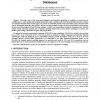7413 search results - page 1469 / 1483 » Using Specularities for Recognition |
BMCBI
2007
13 years 8 months ago
2007
Background: With the advent of increasing sequence and structural data, a number of methods have been proposed to locate putative protein binding sites from protein surfaces. Ther...
BMCBI
2008
13 years 8 months ago
2008
Background: The heterokonts are a particularly interesting group of eukaryotic organisms; they include many key species of planktonic and coastal algae and several important patho...
BMCBI
2008
13 years 8 months ago
2008
Currently, most of the discovered biological and biomedical knowledge is available as textual data in scientific papers. And, locating and curating information about a genomic enti...
BMCBI
2008
13 years 8 months ago
2008
Background: Despite increasing interest in applying Natural Language Processing (NLP) to biomedical text, whether this technology can facilitate tasks such as database curation re...
BMCBI
2008
13 years 8 months ago
2008
Background: A multiple sequence alignment (MSA) generated for a protein can be used to characterise residues by means of a statistical analysis of single columns. In addition to t...

